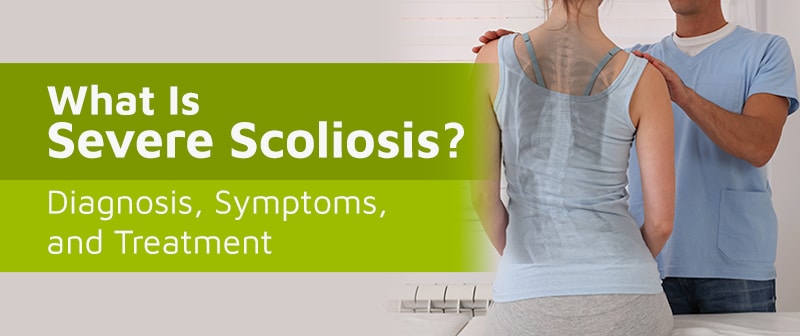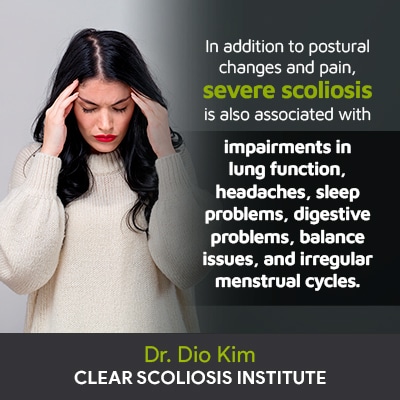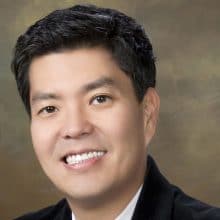
Every case of scoliosis is unique and will affect patients differently. Variables like patient age and condition severity help shape a person's experience of life with the condition. Treatment plans for patients, of all severity levels, have to be designed around the needs of each patient and their specific condition; there is no generic blanket-approach to treating scoliosis. As severe scoliosis has a high risk of progression, the condition needs to be taken seriously and treated proactively; the sooner, the better.
Scoliosis develops across a wide severity spectrum of mild to moderate and severe. Scoliosis is classified as ‘severe’ if the abnormal spinal curvature has a Cobb angle measurement of 40+ degrees. Cases of severe scoliosis are virtually guaranteed to progress, which is why proactive treatment is key.
Before we explore the specifics of severe scoliosis in terms of symptoms and treatment, let’s start with how conditions are diagnosed and assessed.
In order for a diagnosis of scoliosis to be given, certain condition parameters have to be met.
Scoliosis involves having an abnormal sideways spinal curvature, but that curvature has to include rotation, making it a 3-dimensional condition, and be of a certain size.
The size of a scoliotic curve is determined by a measurement known as ‘Cobb angle’. A patient’s Cobb angle is measured during X-ray by drawing intersecting lines from the tops and bottoms of the curvature’s most-tilted vertebrae (bones of the spine). This involves multiple vertebrae and places a condition on its severity scale of mild, moderate, or severe.
Mild scoliosis: Cobb angle measurement of between 10 and 25 degrees
Moderate scoliosis: Cobb angle measurement of between 25 and 40 degrees
Severe scoliosis: Cobb angle measurement of 40+ degrees

See: Common Methods for Assessing Scoliosis
People with severe scoliosis have experienced progression and are likely to continue progressing if an effective and proactive treatment plan isn’t applied.
As we have addressed what it means to be diagnosed with severe scoliosis, let’s move on to some common symptoms of the condition.
As previously mentioned, every case of scoliosis is as unique as the patient affected, and while every case is different with its own treatment needs, there are some common symptoms characteristic of life with severe scoliosis.
As scoliosis develops, it introduces a lot of uneven forces to the body, the spine, and its surrounding muscles and nerves.
In cases of severe scoliosis, these patients are in the later stages of progression, and symptoms that might have started out as mild are likely to increase alongside progression, such as postural changes and pain (more common in adults).
Postural Changes
One of the earliest telltale signs of scoliosis involves postural changes that affect the body’s overall symmetry. Again, while every case is different, as a curvature increases in size, it tends to cause more noticeable postural deviation:
As a result of these types of postural changes that give the body an asymmetrical appearance, clothing tends to hang unevenly, and changes to balance, coordination, and gait are also common.
In addition, with severe scoliosis patients, it’s not uncommon to be able to see the spine’s abnormal curvature and rotation with the naked eye; whereas in mild, and even some moderate cases, these qualities aren’t commonly noticeable to people who aren’t trained in how to recognize condition indicators.
In general, the progressive line from mild to severe involves symptoms evolving from subtle and difficult to notice, to overt and difficult to miss.
As the most effective indicator that something is wrong with the body, pain can also be a common symptom of severe scoliosis, but more so in adults than in children and adolescents.
Pain
Another important condition variable to understand is pain. While an abnormal spinal curvature can seem like it would always cause noticeable pain, this is not necessarily the case, particularly when it comes to the difference in how adults and adolescents commonly experience the condition.
While the likelihood that scoliosis will be painful can increase based on the angle of trunk rotation (ATR) and condition severity, whether a condition is painful or not is also largely determined by patient age, and this is due to skeletal maturity.
In children and adolescents who have not reached skeletal maturity, the spine is experiencing a constant lengthening motion due to growth, and this counteracts the compressive force of the unnatural curvature; however, in adults whose spines have settled due to gravity and maturity, they are vulnerable to compression felt in the spine and its surrounding muscles and nerves.
In fact, when it comes to adult scoliosis, pain is often the most noticeable symptom and is what brings them in to see me for a diagnosis and treatment.
So while approximately 20 percent of adolescents experience muscle pain related to their condition, even in severe cases, the condition isn’t always painful.
In adults, in addition to postural changes that include a prominent lean to one side, plus the aforementioned symptoms, pain can be the most noticeable symptom of severe scoliosis.
While postural changes and pain are the most common symptoms of severe scoliosis, additional symptoms reveal how the condition can affect the body in many ways.
Additional Symptoms of Severe Scoliosis

As the spine works in tandem to form the body’s central nervous system (CNS), spinal conditions can have a wide range of effects felt throughout the body, and scoliosis is no exception.
So if a person is diagnosed with severe scoliosis, what’s next?
Throughout the article, I’ve highlighted some condition-related variables that are particularly important to understand; another area of crucial importance is treatment.
Patients, and their families, need to understand that different treatment approaches offer different potential outcomes, so the decision of which treatment approach to commit to can have life-long consequences.
There are two main scoliosis treatment approaches: chiropractic-centered and traditional.
Here at the CLEAR Scoliosis Institute, our team of CLEAR-certified scoliosis chiropractors offer a chiropractic-centered approach that values proactive treatment and addresses the underlying structural nature of the condition.
We also value treating the whole patient and the condition itself, not just its symptoms; this is an important distinction because solely addressing a condition’s symptoms is not akin to treating the underlying cause of those symptoms, which is the condition itself.
The CLEAR approach is also referred to as conservative and involves integrating multiple treatment disciplines for the most effective and customized treatment plans possible.
We combine scoliosis-specific chiropractic adjustments, a variety of therapies, scoliosis-specific exercises, and balance-training exercises. While CLEAR scoliosis treatment does not typically involve the use of a brace, a well-designed corrective brace can complement CLEAR treatment.
The results of the CLEAR approach speak for themselves and offer patients the benefits of synergistic treatment that, unlike the traditional approach to scoliosis treatment, doesn’t funnel them towards invasive spinal-fusion surgery.
Under the umbrella of traditional treatment, patients are mainly observed while the condition is mild, but once a condition progresses into the severe classification and passes the surgical-level threshold, spinal fusion is commonly recommended as the best treatment option.
While spinal fusion can help straighten a scoliotic spine, the way it’s achieved can come at a heavy price. In addition, it’s an invasive procedure, and results can never be guaranteed. Many patients are also disappointed with their pain and mobility levels post-surgery; life with a fused spine can come with some unexpected dynamics and limitations.
While it’s true that treating severe scoliosis is more challenging than milder forms, which is why many people mistakenly assume surgery is their only option, this is not the case; through proactive treatment and hard work, improvements can be made on a structural level, in the form of a curvature reduction, and the spine can be stabilized while simultaneously addressing the underlying cause of related symptoms.
Living with severe scoliosis means living with certain symptoms. While not everyone will experience the same symptoms, or to the same extremity level, there are some that are common enough to signify the presence of the condition and/or further progression.
While scoliosis can range from mild to moderate and severe, many times, conditions remain undiagnosed and untreated for years, until they start to produce more noticeable symptoms, such as postural changes and pain.
Patients with severe scoliosis have Cobb angles of 40+ degrees, and even within one level of severity, there can be a wide range of curvature degrees. A severe curvature, especially if left untreated, can continue to progress well beyond 40 degrees, and for those following the traditional approach to scoliosis treatment, once it crosses that surgical-level threshold, spinal fusion is a common recommendation and choice.
For severe scoliosis patients of the CLEAR Scoliosis Institute, our proactive treatment approach can help them live their best lives by working towards improvements that prevent further progression and the need for more invasive forms of treatment.

CLEAR provides a unique and innovative way of understanding scoliosis. Sign up to receive facts and information you won’t find anywhere else.

I' m 76, have severe scoliosis, arthritis, degenerative spine . Doctor ( nero surgen )told me too, long of a surgery for me, 4 hrs. and not sure I would get any benefit as so many places in back that are bad. (nerves/ bone) . Injections did not work and Ihave ache legs and back feels weak. I've worked hard all my life on a ranch, so very hard to not be able to do work. it has really changed how I live my life.
Do i seek out a chiropractor or acupuncturist or do massage. Please help as pain is getting to me menally and psysically. Thank You
Hello, Donna,
I can imagine that is frustrating for you. Unfortunately, chiropractic colleges do not train Doctors in treating scoliosis. In order to get some relief or stability of your scoliosis, I recommend seeing a Chiropractor who has specialized training and postgraduate studies on scoliosis. Our CLEAR Scoliosis Institute certified Doctors have extensive training in the management and treatment of scoliosis, as well as equipment in their offices that is used for the treatment of scoliosis. I recommend you consult with the CLEAR Scoliosis Institute Center closest to you to determine if you would be a candidate for the type of care we provide and if it would be beneficial to you. To find the nearest clinic, please visit our website under Find a Doctor. Please let us know if we can be of further assistance.
I hAVE SEVERE SCOLIOSIS AND I HAVE RECENTLY GAINED 60 LBS IN A 6 MONTH PERIOD. BACK IN 2012 MY SPINE WAS PRESSING ON MY LUNG WHICH CAUSED ME TO LOSE 30 %LUNG FUNCTION COULD IT BE POSSIBLE FOR MY SPINE TO BE PRESSING ON MY ADRENAL GLANDS CAUSES THEM TO NOT WORK PROPERLY WHICH COULD CAUSE MY WEIGHT GAIN
Hello, Santana,
Adrenal glands can have an effect on weight gain and vice versa. If you are having unexplained weight gain, you should consult with your primary care provider to rule out anything concerning. If you feel as if your scoliosis has been affected by your weight gain, I would suggest contacting one of our CLEAR Scoliosis Institute certified doctors for a consultation. Typically weight gain will cause increased pain, stiffness, etc. on a person with scoliosis. Our CLEAR Doctors can help with formulating a customized exercise plan to address your scoliosis curvature and help alleviate your symptoms. To find the nearest CLEAR Scoliosis Center, please visit our website under Find a Doctor. Best of luck.